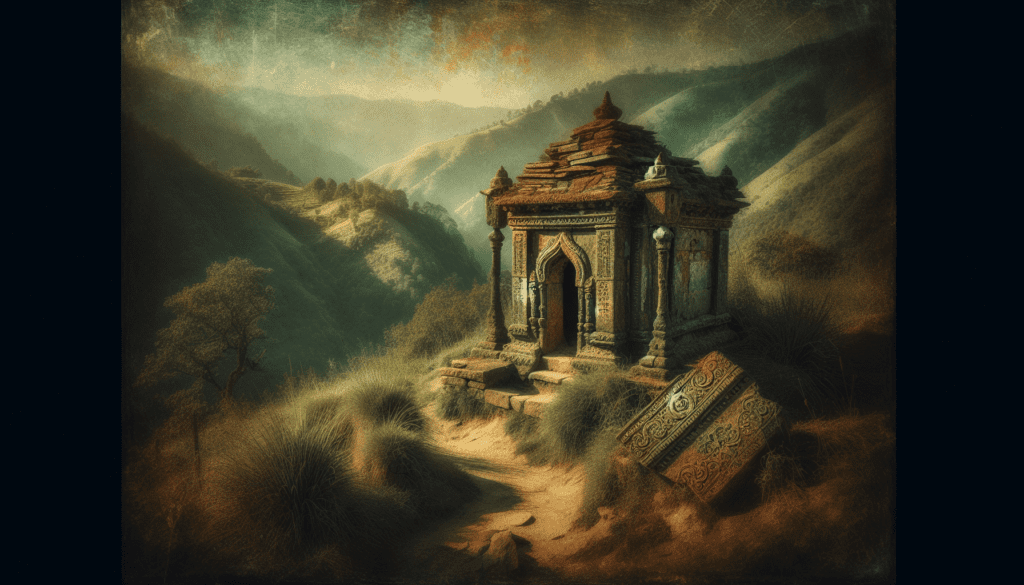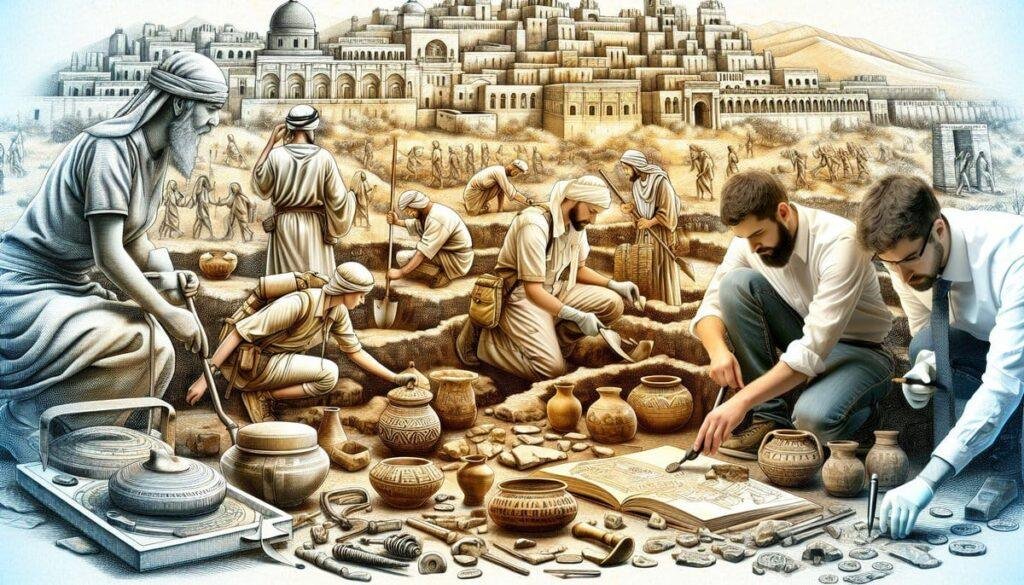What if you stumbled upon an ancient shrine, steeped in mystery, that once housed relics beside the elusive Ark of the Covenant? Such a discovery could take you down a winding path of history, faith, and intrigue. The Remote Hill Shrine presents an opportunity to unveil secrets from long ago, connecting today’s world with the ancient past.

Unearthing the Remote Hill Shrine
Imagine standing on a remote hillside, surrounded by whispers of the ancient world. The terrain, rugged yet serene, seems to cradle secrets. This isn’t just any place; it’s a sanctuary interconnected with biblical history. The Remote Hill Shrine, which may—or may not—have seen the Ark of the Covenant, offers a fascinating canvas painted with the colors of faith, belief, and human endeavor.
What is the Remote Hill Shrine?
At its core, the Remote Hill Shrine serves as a site of worship, potentially linked to the location of ancient Israelites’ ceremonial practices. Scholars and archaeologists have debated the exact coordinates of significant biblical events, and here lies one puzzle that invites contemplation.
The shrine is characterized by its simple structure, typically comprising an altar where offerings may have been made to God. Remnants of pottery, tools, and other artifacts often surround such sites, hinting at the lives of those who once worshipped there. The spatial orientation and architecture can tell you a lot about its purpose.
Significance of Relics Beside the Ark
You might wonder why relics found next to the Ark of the Covenant hold such a prominent place in history. The Ark, as outlined in the Scriptures, was considered God’s dwelling place on Earth. It housed the tablets of the Ten Commandments, and its significance spurred awe and reverence among the Israelites.
Key Relics Associated with the Ark:
- The Ten Commandments: These stone tablets served as a moral compass, guiding the Israelites in their covenant with God.
- Aaron’s Rod: A symbol of divine authority, this rod famously blossomed, signifying God’s choice of Aaron as high priest.
- A Jar of Manna: Representing God’s provision during the Israelites’ wilderness journey, this relic is a reminder of faith and sustenance.
In a physical sense, any relics discovered near the Remote Hill Shrine could provide insight into how these items were used in public worship and their impact on community life.
The Historical Context
To understand the Remote Hill Shrine and its relevance, you must take a step back into the annals of history. The period surrounding the establishment of the Ark and various shrines is fascinating, indeed.
Time Period of the Ark’s Significance
The Ark of the Covenant was crafted during the Exodus period, around 1446 BCE, and its presence was pivotal throughout the Israelites’ journey to the Promised Land. In a world filled with competing ideologies and emerging civilizations, the Ark represented a central, unifying object of worship.
That leads to the question of how shrines like this were established. Often, these sites were constructed in locations deemed ‘holy’ or special due to their proximity to other significant historical events. With oral traditions playing a considerable role, the stories surrounding the Ark would have fueled interest in establishing places of worship where people could feel close to the divine.
Archaeological Discoveries: Gaining Insight
You may find it intriguing that archaeology plays a critical role in mapping out these ancient narratives. The Remote Hill Shrine has been the subject of various excavations over the years. Here’s what archaeology has revealed:
| Findings | Significance |
|---|---|
| Pottery Shards | Indicate the everyday lives of worshippers. |
| Stone Altars | Suggest places for sacrifices and communal worship. |
| Human Remains | Point to burial practices and connections to the community. |
Each artifact unearths stories that weave together the religious and the social fabric of the time. Archaeologists often collaborate with historians and theologians to gain context about their findings, leading to a fuller understanding of the shrine’s importance.
The Role of Faith in Ancient Communities
What you might find especially captivating is how deeply rooted faith was in daily life back then. The connection between the sacred and the mundane was seamless. Rituals performed at shrines weren’t just acts of worship but intertwined with cultural identity, social structures, and moral guidance.
The congregation often gathered as a community, signifying loyalty not only to God but also to one another. The Remote Hill Shrine would serve as a central point for such gatherings, a social hub where faith flourished alongside community bonds.

Theological Interpretations
When you think about the Ark of the Covenant and the shrine, theological interpretations come into play. Different traditions view these subjects through diverse lenses, each adding layers of understanding to the narrative.
The Ark in Judaism
In Jewish tradition, the Ark embodies the covenant between God and His chosen people. It is revered as the ultimate symbol of divine presence. The Remote Hill Shrine could potentially represent an extension of this relationship, drawing people closer to their covenant with their deity.
The Ark in Christian Theology
For Christians, the Ark has even broader implications. It prefigures the concept of God dwelling among humankind, embodied in Jesus Christ. The relics associated with the Ark can symbolize that profound connection, creating continuity between the old and new testaments. Therefore, a shrine believed to be linked to the Ark carries theological weight beyond its immediate historical context.
Cultural Relevance
Today, you can see how the legends surrounding the Ark stir fascination not just among scholars but within popular culture, too. From films to novels, the Ark serves as a powerful symbol of adventure, mystery, and the human search for divine connection.
Visiting the Remote Hill Shrine: An Insider’s Perspective
While the hidden beauty of the Remote Hill Shrine may not be well-known, your journey could lead you there. Whether you’re a believer or merely a history aficionado, the experience holds its charm.
Location and Accessibility
Finding the shrine may take a bit of adventurous spirit. Nestled in a remote hillside, reaching the location could involve hiking a rugged trail—challenging but rewarding. As you ascend, the breathtaking views will remind you of the compelling stories waiting to be unearthed beneath the ground.
What to Look For
If you ever have the opportunity to visit, keep an eye out for:
- Remnants of Altars: Look for stones that may signify old places of worship.
- Pottery Fragments: These can give richness to your understanding of community life.
- Carvings or Symbols: Any inscriptions might provide further theological insights.
Engaging with Local Knowledge
While ancient texts and archaeological data are enlightening, local wisdom often carries hidden gems. Engaging with historians or archaeologists who have studied the shrine can offer personal anecdotes and scholarly interpretations. You might come away with stories that bring life to the relics you’ve encountered.
Cultural Narratives Inspired by the Shrine
As you unravel the layers of the Remote Hill Shrine, you might find stories that transcend mere archaeological findings.
Tales of Devotion
Ancient narratives often incorporate devotion and sacrifice, with tributes made at such shrines reflecting both individual piety and communal identity. These accounts help you appreciate the enduring nature of faith throughout generations.
Folklore and Legends
The shrine could also be steeped in local folklore—legends that have been passed down through time. You might hear tales of miraculous events or those who sought refuge there, each narrative enriching the lore surrounding the site.
The Future of the Remote Hill Shrine
As you contemplate the centuries of faith and history contained in the Remote Hill Shrine, it’s vital to think about its preservation for future generations.
Archaeological Efforts
Ongoing archaeological efforts help protect and uncover this precious resource. Understanding and documenting the site will not only assist in preserving its integrity but also contribute to the larger tapestry of biblical archaeology.
Engaging Communities
Communities around such shrines have a unique opportunity to engage with their heritage. Hosting events that celebrate both the archaeological and the spiritual can foster deeper connections among locals and visitors alike.
Reflecting on the Journey
Having journeyed through the history and significance of the Remote Hill Shrine, it’s intriguing to consider how the threads of ancient faith and modern identity intertwine. Each step you take toward understanding not only deepens your knowledge of the past but also enhances your grasp on the present.
In summary, the Remote Hill Shrine stands as a poignant reminder of humanity’s quest for connection with the divine. The relics that may have once dwelled beside the Ark of the Covenant symbolize a timeless journey of faith, sacrifice, and community. As you consider these narratives, you can appreciate how they resonate across time, infusing modern life with a rich tapestry of history and spirituality.
So, now that you’ve taken this stroll through ancient hills and sacred stories, what stories resonate with you the most? The shrine invites reflection on your own journey, your narratives, and the ways in which history shapes your beliefs and identity today.


